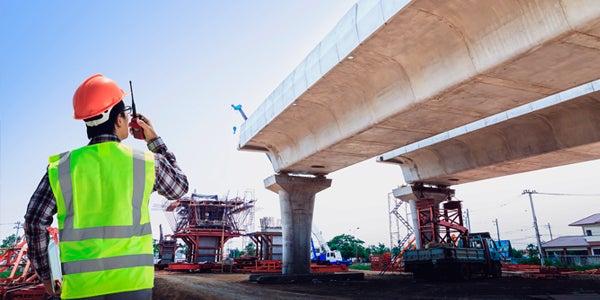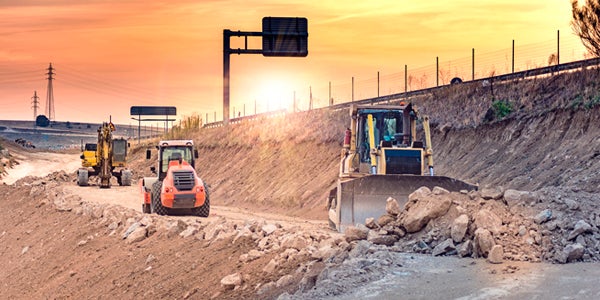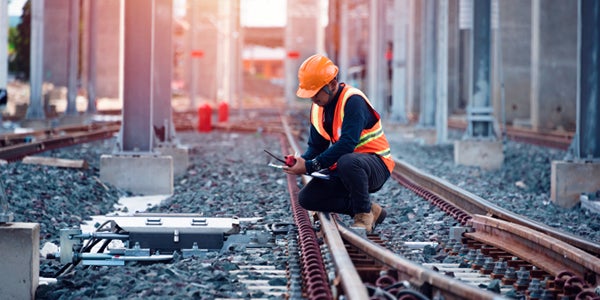The recently passed Infrastructure Investment and Jobs Act (IIJA) has brought a sigh of relief to anyone involved in the construction industry. Over the last two year, this industry has been plagued by Covid strains, labor shortages, and a turbulent geopolitical landscape—all of which leave their mark and marring growth within the sector. Read more here as we discuss in detail the outlook for this industry.
The world-changing events between 2020 and 2022 left their mark on every industry, construction included. Emerging Covid strains stunted new projects, labor shortages hindered ongoing ones, and a turbulent geopolitical landscape made procuring supplies more challenging. Paralyzed business owners were forced to sit and ponder the current outlook of the construction industry—and lobby Congress for help.
That help finally came in the form of the Infrastructure Investment and Jobs Act (IIJA), signed into law in November 2021. After extensive negotiation between the Biden Administration and both houses of Congress, the bill contains a simply staggering amount of money for infrastructure projects—$1.2 trillion overall. It’s the largest investment in American infrastructure in the 21st century. And it may be just what construction firms needed to get back on their feet after Covid-19.
IIJA may be a gift to the construction industry, but that doesn’t mean everything’s better just yet. Knowing how to leverage IIJA is the first step toward profiting in 2022, 2023, and beyond. And inflation remains top-of-mind for business owners across America. As the price of materials and transportation rises, business owners and developers must thoroughly research the outlook for the construction industry, and how IIJA might benefit profit margins.
What’s the Outlook for the Construction Industry as IIJA Rolls Out?

IIJA passed in November, but these projects take some time to roll out. Expect a slow—but steady—increase in demand for new construction services, materials, and equipment over the next few years.
While increased demand is always a good thing, business leaders still face several immediate challenges in Covid-19’s wake. For starters, global supply chain issues are still causing delays at ports, leaving projects sitting stagnant until they get the equipment they need. Meanwhile, geopolitical conflicts and sourcing energy costs are forcing project managers to rethink their budgets.
Even when materials do arrive and the budget gets adjusted for rising energy costs, the construction industry is still suffering from significant labor shortages. Data from Associated Builders and Contractors suggests the industry will need to attract 650,000 new workers on top of normal hiring paces through 2022.
Thankfully, an influx of federal stimulus should create millions of well-paying construction jobs while simultaneously improving economic efficiency and competition. Of the $1.2 trillion in IIJA, $550 billion in new government spending, is a historic investment.
A Focus on Roads and Bridges
The most significant portion of the bill seeks to build and repair the country's roads and bridges, with $110 billion allocated for around 173,000 miles of highway and major roadways. IIJA also targets transit, dedicating $66 billion to upgrade America's passenger and freight rail systems, and more informal infrastructure, with $130 billion for power grid and broadband expansion projects.
All this is to say that the influx of spending signals good news for the outlook of the construction industry. Stephen Sanherr, CEO of the Associated General Contractors of America (AGC), notes that these investments will stir demand for construction services while simultaneously generating high-paying career opportunities. Overall, he believes the bill will make the American economy more “efficient and competitive.” Construction business owners may want to consider capitalizing on the opportunity.
IIJA and Inflation: Dueling Impacts on Materials and Supplies

According to the White House, IIJA is the “single greatest dedicated bridge investment since the building of the interstate highway system.” Allocating $110 billion toward roads, bridges, and highways sounds like plenty of money—but how will it stand up to the rising materials costs? How will the infrastructure bill directly impact construction business owners’ outlook for the next few years?
First off, business leaders are clamoring to know when and how they can bid for these jobs. Is the money currently available? The answer, frustratingly, is currently a bit of both yes and no. Not all $1.2 trillion is currently available to fund public works contracts. The plan is to roll the funding out over the next several years, prioritizing lasting bedrock projects over quick fixes.
Mitch Landrieu, the Biden Administration’s infrastructure implementation coordinator, said it best: “[This] is not a race to see how many ribbons we can cut before the end of the year.” The best thing business owners can do is keep their ear to the ground and track their individual state (or the states they operate in) rollout schedule.
Inflation Scrambles All Investments
Business owners are well aware of how out-of-control prices became for essential materials like copper, lumber, steel, and cement in 2021. AGC’s Construction Inflation Alert 2022 lays out just how much overall construction costs increased between 2020 and 2021. The PPI for new, nonresidential construction—excluding labor costs, equipment purchases, and direct imports—rose by a record amount. The index increased by 24.1% between June 2020 and June 2021, only to dip slightly come December. Still, prices sit well above what many business owners are used to paying.
Buy American Stipulations
IIJA floods the sector with new money for projects, but they also come with some stipulations that will affect budgets. The money often comes attached to an extension of “Buy American” regulations, requiring goods purchased with federal funds to be manufactured in the United States. Traditionally, such regulations were the domain of public works, transportation, and water-related infrastructure jobs. IIJA expands these stipulations to more federally-funded projects like transmission facilities and broadband infrastructure.
IIJA also expands “Buy American” subsidies to more goods and materials, including copper, plastic, and polymer-based materials, glass and optical fiber, lumber, and drywall—among other common construction materials.
Benefits of the Infrastructure Bill to Construction Companies

IIJA infuses an astronomical amount of spending into American roads, bridges, utilities, and other infrastructure initiatives. Contractors and construction business owners may want to clear their calendars for the next few years as the influx of funds into state coffers bolsters public works jobs. Let’s see how the money might shape the outlook of the construction industry in coming years—and which contractors will benefit most.
Roads, Roads, Roads
Highway contractors stand to profit significantly from IIJA. The bill includes the Surface Transportation Reauthorization Act, providing $304 billion over five years for highway, road, and bridge projects. According to AGC, this is a 34% increase from traditional levels.
Using a funding formula, $274 billion will go to the states. They'll then distribute the remaining funds to programs like the National Highway Performance Program, the Surface Transportation Block Grant Program, the Highway Safety Improvement Program, and Federal Lands and Tribal Transportation and INFRA (Infrastructure for Rebuilding America) grants.
President Biden pushed heavily for IIJA to look to the future with a green eye, and that includes electric vehicles. The Electric Vehicle Charging and Alternative Fuel Infrastructure Program gets $7.5 billion in order to incentivize EVs and build charging stations.
Fixing Utilities—Old and New
Utility contractors will also likely profit from IIJA. The bill delivers historic levels of funding for water infrastructure, with a goal to replace much of the country’s lead piping—among other ambitious utility projects. What else might see an influx of federal funds over the next five years?
IIJA allocated $55 billion for Clean/Drinking Water State Revolving Funds to bolster current systems against climate change. It also directs much-needed aid to low-income communities without clean drinking water.
Broadband infrastructure was also a significant component of IIJA, as the Biden Administration wants to expand high-speed connectivity to underserved communities. Roughly $42.5 billion will go towards infrastructure, mapping, and high-speed internet adoption projects.
The US electric grid will receive considerable funding for projects to reduce wildfire risks, among other dangers to the nation's grids. IIJA allocated $6 billion toward transmission, distribution, and storage infrastructure to improve resiliency. Furthermore, $50 million will go towards building or replacing transmission lines to increase capacity.
The Construction Industry Outlook: It’s All About Transit
Business owners can also capitalize on further funding geared towards transit, railways, airports, and seaports. Over the next five years, $69.9 billion will go towards surface transportation reauthorization, with $36 billion divided between Capital Investment Grants and Transit Infrastructure Grants. Meanwhile, IIJA also puts $25 billion toward improving American airports through rehabilitation projects, upgraded terminals, and ATC facilities, while increasing airport access capacity.
Leverage Opportunities Brought by the Infrastructure Bill

Now that massive sums of money are flooding towards everything from highways and bridges to airports and broadband infrastructure, business owners must ask themselves if they're ready to leverage the opportunity. The outlook for the future of the construction industry is bright. Is your company prepared to take the necessary steps to seize it?
We know where the money is going, and roughly when it will start flowing out. The best thing you can do for your business is position yourself to win these government contracts. If you haven't already, make sure you're registered with a handful of industry databases, like the System Award Management (SAM) and General Services Administration (GSA). These organizations make it easy for the government to find your business and award you with contracts.
However, you'll also need a unique entity identifier (UEI) number to do business with the government. Currently, the DUNS number—a nine-character ID provided free of charge by Dun & Bradstreet—is the accepted UEI for government contracts.
Once you're registered with the right entities, it’s time to start bidding for government infrastructure contracts. The IIJA puts many construction companies in an unfamiliar position, especially if they've never worked with publicly-funded contracts. Because the taxpayers are funding these infrastructure projects, they expect efficient results that are under budget and on time. However, according to McKinsey, 80% of large construction projects wrap over budget and take 20% longer than expected. So what can businesses do to spin this negative construction industry outlook in a more positive direction?
Where Your Focus Should Lie
Companies must prepare to invest in efficiency-driving technologies to leverage these opportunities. By all accounts, the construction industry lags behind other titans regarding technological investment. Automation, augmented reality (AR), AI, and the Internet of Things (IoT) are highways to the future. Instead of sticking to “tried and true” methods, companies looking to win government contracts must invest in innovative tech.
According to market data from CB Insights, the industry appears to be trending in the right technological direction. Between 2015 and 2019, the construction tech sector saw $5.1 billion allocated toward funding start-ups. Those trends continued well through Covid-19 and should carry on into the future as IIJA money flows into states.
Take the Steps You Need—Now
The future outlook of the construction industry shows plenty of opportunity on the horizon thanks to IIJA. However, business leaders must ensure their companies are ready to pounce or risk falling behind the competition. The path ahead isn't the surest shot, as inflation keeps affecting prices and Fed continues to talk about interest rates.
Considering all these variables, construction businesses must consult with a reliable financial partner like First Bank & Trust, a division of HTLF Bank. Understanding the inner workings of 2,000+ page government documents isn't easy, and investing in modern technology is pricey. Thankfully, a trusted financial partner with construction industry expertise can help guide you through this new journey. Contact First Bank & Trust, a division of HTLF Bank today to learn more about how you can leverage IIJA for your construction business.







